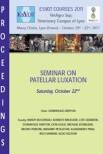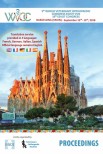Objective: The aim of this study was to identify the ideal anchor point for patellar anti-rotational sutures for adjunctive stabilization of medial patellar luxation in both small and large breed dogs.
Study design: Retrospective radiographic survey was performed on 110 stifles from 101 dogs. Radiographs were grouped based on patient weight (≤15 kg; >15 kg) and diagnosis (medial patellar luxation, cranial cruciate ligament rupture, and normal joints). Radiographic measurements included: the proximal, middle, and distal points of the trochlear ridge, the caudal aspect of Blumensaat's line (roof of the intercondylar notch), the centre of the lateral fabella, as well as the "best-fit" centre of a circle overlying the trochlea. These landmark coordinates were used to calculate radii for comparison, and for scaling between joints.
Results: Use of the fabellar centre resulted in larger radii (corrected p <0.001) than those from the best-fit circle centre for all but one combination of patient group and trochlear end point locations. Using the best-fit circle centre, radius variation was less marked than with the fabellar centre. Significant differences in location for centres of the best-fit circle and fabella were seen across all patient categories (Pillai's trace p <0.001).
Conclusion: The fabella is unlikely to be the best choice for anchoring a patellar anti-rotational suture. Use of the best-fit circle centre to place a suture anchor should be preferred to maximise suture isometry during joint flexion and extension in large and small breed dogs.









